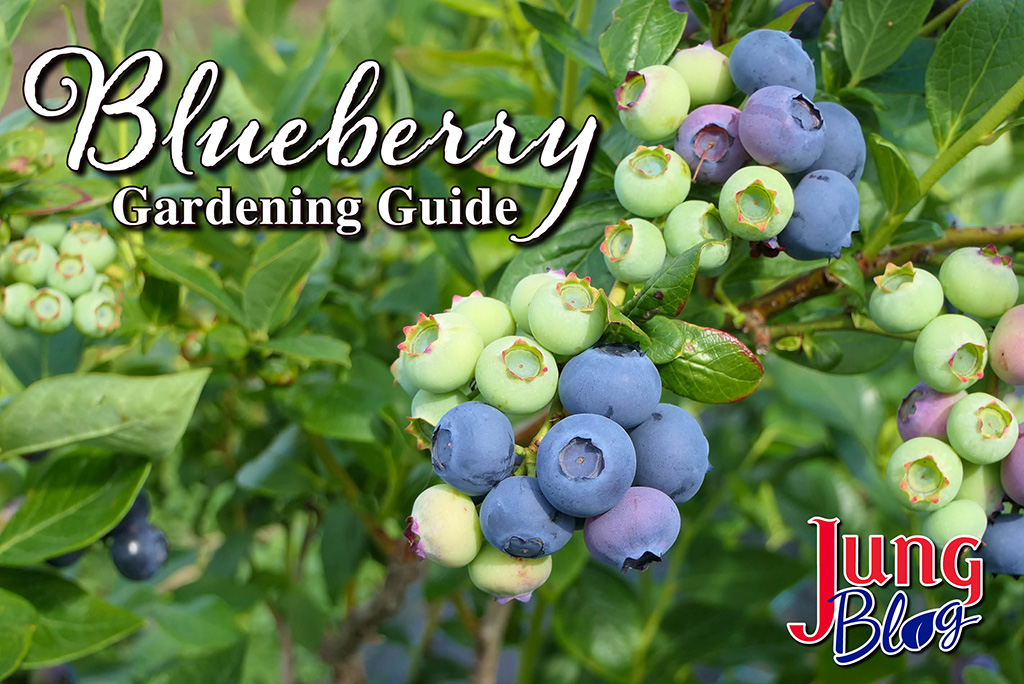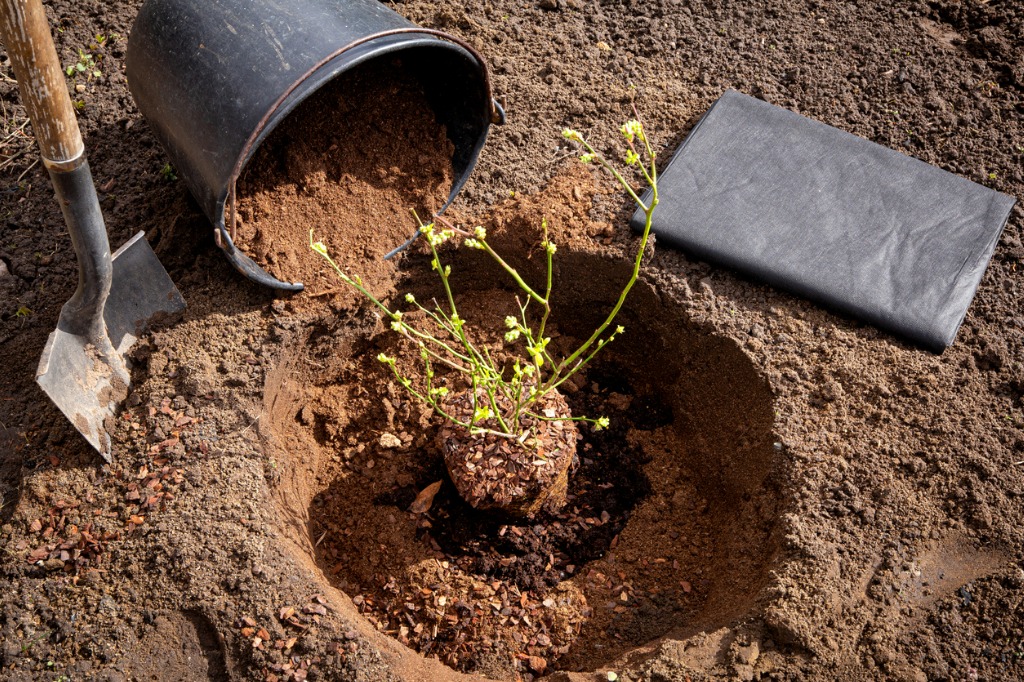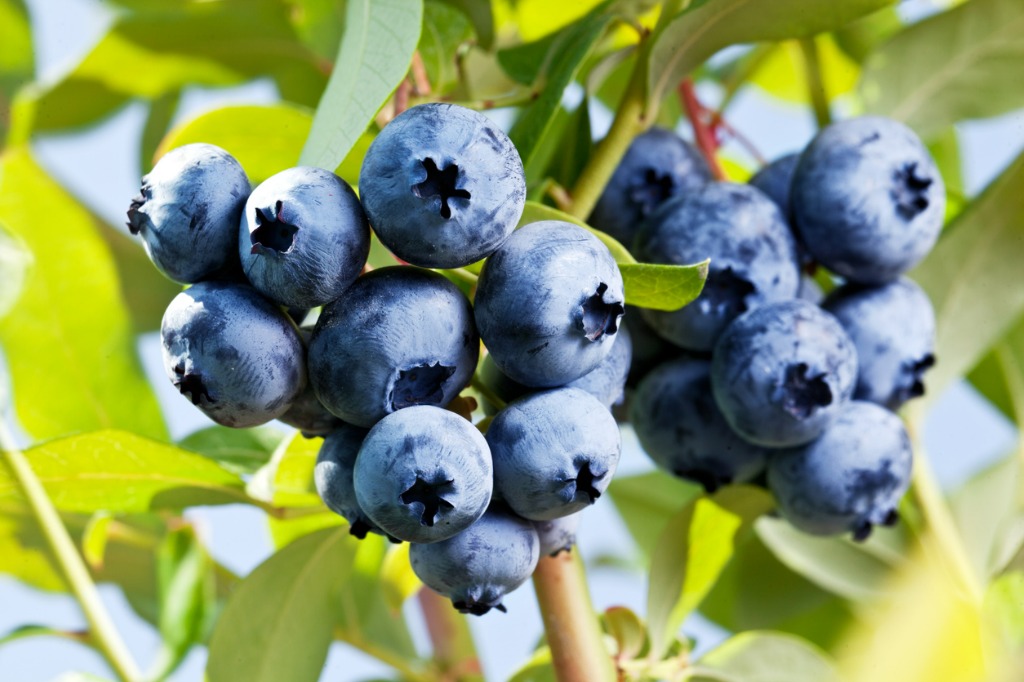
Blueberries are a delicious and nutritious fruit that can be grown easily in many regions. Whether you are an experienced gardener or just starting out, growing your own blueberries can be a rewarding and fulfilling experience. Not only do they provide a bountiful harvest of sweet, juicy berries, but they also offer a host of health benefits, including antioxidants and vitamins. In this guide, we will cover the planting and maintenance to grow blueberries.
Blueberry Quick Tips
- Plan to acidify soil by adding sulfur/compost blend at least a year prior to planting.
- For the best results, the pH should be maintained at 4.5-5.5.
- Prune new bare root plants back by about ½ after planting.
- Remove first-year blossoms.
- Planting more than one variety ensures good cross-pollination.
- Blueberry roots are shallow, avoid cultivation around their base.

Blueberry Planting Guide
When To Plant Blueberry Bushes
Dormant, bareroot blueberries may be planted as soon as the ground can be worked in early spring. Potted blueberries that arrive with foliage require hardening off, then planted after the threat of frost has passed.
Selecting An Appropriate Blueberry Planting Site
Choose a location in full sun but free from heavy winds. Avoid low-lying areas where standing water can accumulate. Lose, organically rich, well-drained acidic soil is best. Blueberries do not thrive in heavy clay soils.
How To Amend The Soil For Your Blueberry Bushes
Blueberries require acidic soil with a pH of 4.5 to 5.5. The soil pH should be tested, and soil sulfur should be added to properly lower the pH to this acceptable range for blueberries to thrive. Different soil types and moisture levels will dictate how much sulfur to add. Altering soil pH is a long process. Soil sulfur should be added 1 year prior to planting. If you have not done this yet, do not panic. For this season, at planting time mix ¼ to ½ lb. of Aluminum Sulfate per plant with other proper and necessary soil amendments like peat moss, leaf compost, and aged manure. Plan to add appropriate soil sulfur in the early spring of the 2nd year in the ground.
Soaking Your Blueberry Bare Roots
Prior to planting, soak plant roots for 8 hrs. up to but not longer than 24 hrs. in a bucket of clean water. Amend the soil, while the roots are soaking. See the notes above regarding proper soil amendments.
NOTE: DO NOT use potting soil as an amendment. DO NOT add additional fertilizer other than the bone meal or super phosphate fertilizer at planting.

How To Space Your Blueberry Plants
Space half-high or high bush blueberry plants 4 to 5 ft. apart with rows of 8 to 10 ft. apart. Space dwarf blueberry varieties 2 to 3 ft. apart with rows 5 to 6 ft. apart.
NOTE: Blueberries are self-fruitful, but mature plants will bear more and larger fruits if they are planted with a different variety, that blooms at the same time to provide cross-pollination.
How Much Mulch Should I Add Around My Blueberry Bush
After planting, mulch around the base of each plant with 4 to 6 inches of leaf compost or mulch to help maintain soil moisture, reduce soil surface temperature, and help suppress weeds.
NOTE: DO NOT cultivate or dig around the base of blueberry plants, they have very shallow and extensive root systems that are easily damaged.
Pruning Your Blueberry Plant After Planting
After the blueberry plants are in the ground, tip prune all stems or branches back by 1/2. Tip pruning balances the top of the plant to the roots that it currently has. Importantly, it also removes first-year fruit buds. DO NOT skip this step.
How Often Should I Water My Blueberry Bush
Water the new blueberry plants thoroughly to remove air pockets. Maintain consistent water of at least 1 in. per week, per plant. This equates to about 2.5 – 3 gallons every 2 to 3 days. Roots are shallow so frequent waterings are beneficial until established, which can take up to 1 year.
Which Vegetables Should NOT Be Planted Near Blueberry Plants
The low pH needed for blueberries is not conducive for most other plants. Here is a list of vegetables to avoid planting near your blueberry plants.
| Asparagus | Cabbage | Radish |
| Beans | Cauliflower | Rhubarb |
| Beets | Lettuce | Spinach |
| Broccoli | Onion | Summer Squash |
| Brussel Sprouts | Peas |

Blueberry Maintenance Care
Blueberries mature to bearing age in 3 to 6 years depending on the type. High bush takes the longest to mature.
Fertilizing Your Blueberry Bushes
Blueberries are moderate to heavy feeders, however, maintaining proper soil pH is the most critical factor affecting soil nutrition for blueberries. The proper pH range for blueberry health is 4.5 to 5.5. If the pH gets too high, the plants may display adverse symptoms including stalled, stunted growth, leaf discoloration from red to pale green, or even plant death. Some nutrient deficiency symptoms may look similar. Test the pH first before applying any fertilizers.
The amount of fertilizer applied will increase as the plant mature. From years 2 to 3, use a balanced 10-10-10 fertilizer at a rate of 1 lb. per 100 sq. ft. of row. Or 1/4 to 1/2 cups per plant applied in early spring. Water-soluble food such as Jack’s Classic® Acid Special (17-6-6) at the rate of 1 Tbs. per gal., once every 10-14 days from April to mid-July. Also, apply 2 to 4 inches of aged manure as top-dressing around the base of each plant, keeping it back at least 2 inches from the main stems.
NOTE: Adding soil sulfur once every 3 to 4 years will help maintain proper soil pH. But don’t guess, do a test!
Removing The Flowers From Your Blueberry Plant
Removing first-year blossoms off new plants is recommended in every situation. Stressed or struggling plants may need flowers removed in the second season as well. Flowering and fruiting zap the energy from the plant. Removing the blooms reduces stress and diverts energy to the foliage and roots for proper growth. By year 3, blueberry plants can be allowed to set fruit.
Pruning Your Blueberry Bush
Proper pruning is critical for fruit production. Starting the second year, in late winter to early spring, prune out all weak, broken, or diseased branches. As with many other fruiting shrubs, blueberry fruits are formed at the tip of the branches. Tip pruning mature fruit-bearing plants remove fruiting bud-wood. No tips, no fruit! The best fruits are produced on 1-year-old wood. After 2 to 3 years, pruning out older canes all the way to the ground will make space and sunlight for new fruiting stems to grow to perpetuate their potential for fruits.

Growing blueberries can be a rewarding and fruitful experience, both literally and figuratively. By following the tips and guidelines outlined in this guide, you can successfully cultivate your own delicious and nutritious blueberries. From selecting the right location to providing proper care and maintenance, every step of the process plays a crucial role in ensuring a bountiful harvest. Whether you are a seasoned gardener or just starting out, growing blueberries can be a fun and enjoyable hobby that yields healthy and delicious results.
Other Recommended Reading

- Easy Tips For Pruning Berry Bushes
- An Easy Guide To Fertilizing Blueberry Plants
- Small Berries & Tips On Growing Them
- 7 Heart-Healthy Foods You Can Grow
- 24 Flowers, Fruit, & Plants Perfect For Your Patriotic Garden
- 11 Watering Tips For Your Garden
At Jung Seed Co, we strive to be your go-to guide for all your gardening needs. Our YouTube channel Jung Garden Center has a variety of videos where our experts provide gardening tips for all levels of gardeners. When you need reliable gardening advice, turn to the trusted experts at Jung.
View our new catalog online or browse our website for your gardening favorites. To receive info on new products, exclusive deals, and specials, be sure to sign up for our weekly email. Join our Facebook page, to discuss all things gardening!
